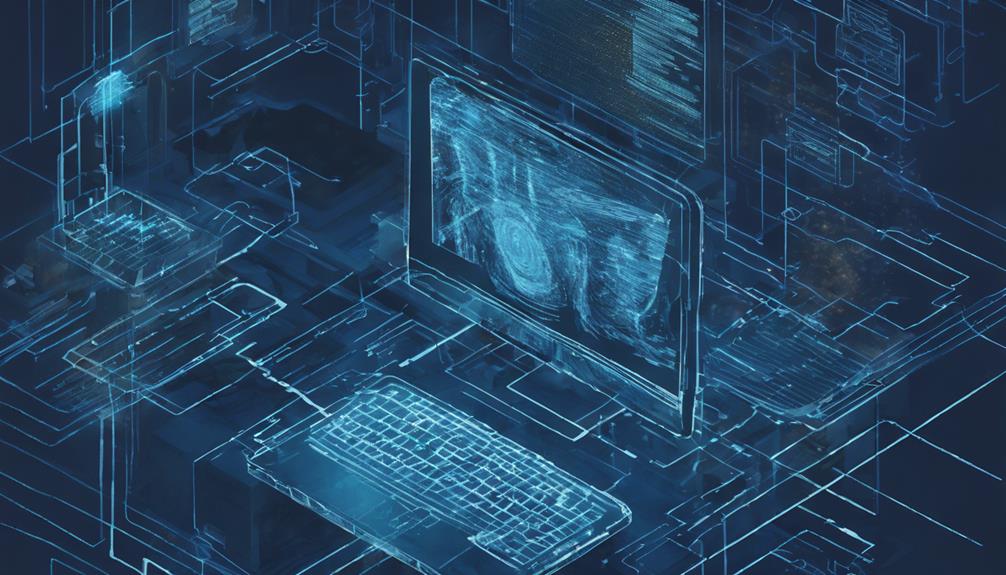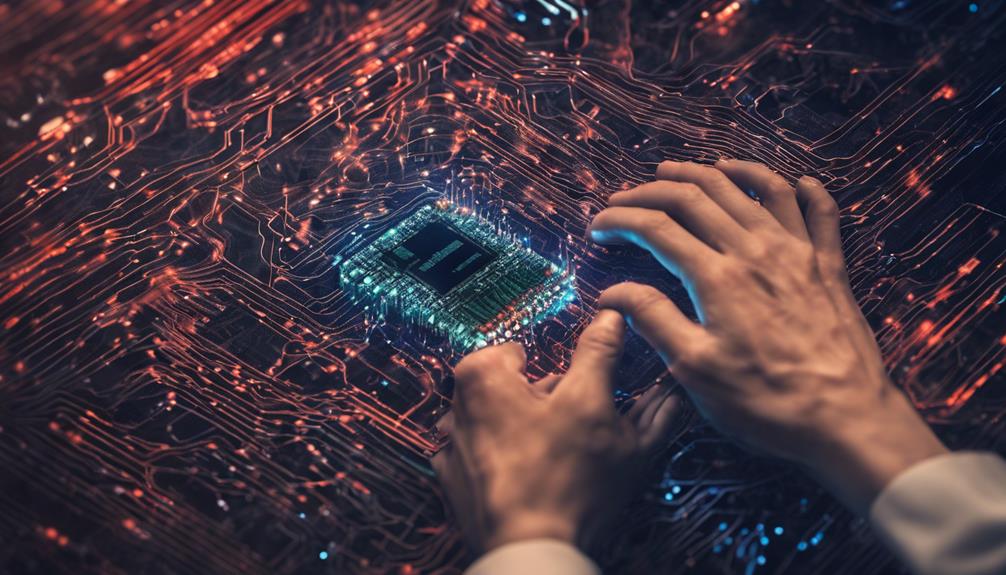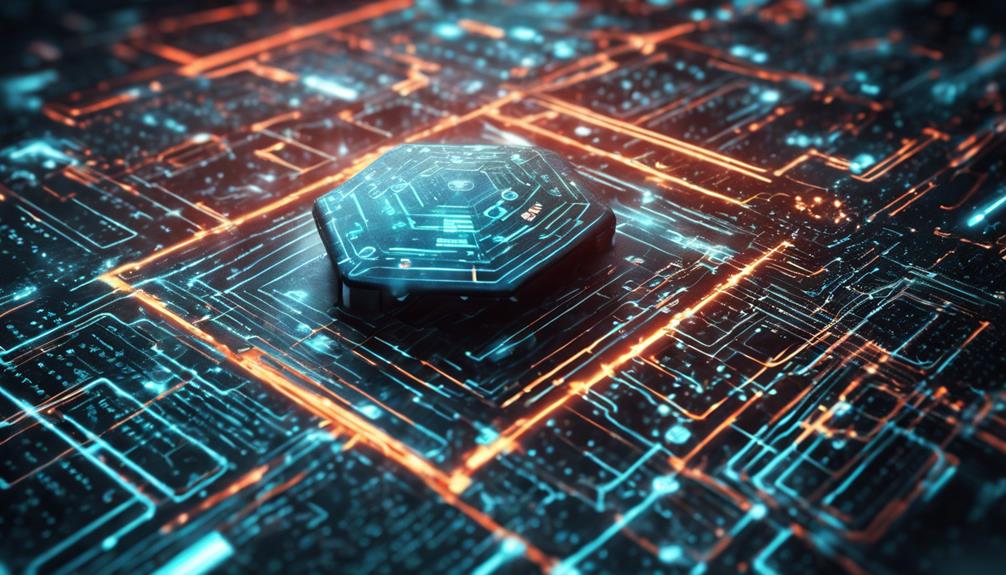To navigate generative AI cybersecurity risks effectively, beware of deceptive content in phishing attacks, potential data breaches, and financial losses. Watch out for personalized email creation, which may evade traditional security measures. Guard against exposure of sensitive data and legal repercussions. Address biases in AI models, unforeseen vulnerabilities, and privacy violations promptly. Stay alert for model drift, IP leakages, and compliance breaches. Proactively mitigate risks, uphold data integrity, and implement robust security measures. Protect against deepfakes, disinformation, and accidental data leaks. These strategies will bolster your defense against evolving cybersecurity threats.
Key Takeaways
- Deceptive phishing attacks with highly convincing content.
- Automated creation of personalized, malicious emails.
- Risks of data breaches and financial losses.
- Vulnerabilities leading to IP leakage and data overflow.
- Compliance challenges with AI misuse and regulatory adherence.
Risks of AI-Generated Phishing Attacks
AI-generated phishing attacks have emerged as a significant cybersecurity threat due to their ability to create highly deceptive content that can deceive users effectively. These attacks leverage AI technology to craft convincing fake emails, increasing the risks of data breaches and financial losses for organizations.
By automating the creation of personalized and targeted phishing emails, AI enhances the volume and success rate of these attacks, making them more challenging to detect. This poses a serious threat to data security, as AI-generated phishing emails can circumvent traditional email security measures and manipulate users into revealing sensitive information.
To combat this growing menace, organizations must strengthen their cybersecurity defenses to effectively detect and prevent AI-generated phishing attacks. Implementing advanced email security protocols, conducting regular employee training on identifying phishing attempts, and employing AI-powered cybersecurity solutions are vital steps in safeguarding against the risks posed by AI-driven phishing attacks.
Stay vigilant and proactive in the face of evolving cybersecurity threats.
Data Privacy Concerns in Cybersecurity

Data privacy concerns in cybersecurity are critical due to the potential exposure of sensitive information. Implementing data in generative AI systems can lead to privacy violations and regulatory non-compliance, posing risks to individuals and organizations alike.
To guarantee protection, robust measures must be in place to safeguard personal data, maintain compliance with privacy regulations, and prevent unauthorized access that could lead to severe legal consequences.
Privacy Regulations Impact
Privacy regulations significantly impact the landscape of generative AI cybersecurity by imposing strict penalties for data breaches and non-compliance with laws such as GDPR and CCPA. Data Protection Regulation (GDPR) mandates fines of up to €20 million or 4% of global turnover for organizations failing to protect sensitive data adequately.
Similarly, non-compliance with the California Consumer Privacy Act (CCPA) can lead to penalties of up to $2,500 per violation or $7,500 for intentional violations. Generative AI security faces heightened privacy risks due to the potential misuse of personal information, necessitating stringent regulatory compliance measures.
Organizations utilizing generative AI must prioritize adhering to data protection regulations to mitigate legal liabilities and safeguard against reputational harm. Violating privacy regulations through generative AI usage can result in severe financial and legal consequences, emphasizing the critical importance of maintaining regulatory compliance in the cybersecurity domain.
Personal Data Protection
Effective cybersecurity practices involve implementing rigorous measures to safeguard personal data from unauthorized access and misuse. Personal data protection is critical in cybersecurity due to the inherent privacy risk associated with handling sensitive information, such as Personally Identifiable Information (PII).
Regulations like the General Data Protection Regulation (GDPR) and the California Consumer Privacy Act (CCPA) emphasize the importance of safeguarding personal data to prevent privacy violations.
Security risks associated with generative AI technologies further underscore the need for robust data protection measures. Improper handling of personal data can not only lead to legal consequences but also result in severe reputational damage for organizations.
Cybersecurity measures like encryption, access controls, and regular security audits are essential for safeguarding personal data from potential breaches. By prioritizing personal data protection, organizations can mitigate financial losses and maintain customer trust in an increasingly data-driven world.
Compliance and Cybersecurity
Compliance with data privacy regulations is a paramount aspect of cybersecurity operations, particularly in the context of generative AI technologies. Data privacy concerns are at the forefront of cybersecurity, with regulations like GDPR and CCPA mandating strict compliance measures to safeguard personal data. Non-compliance can lead to significant fines and damage to the reputation of organizations utilizing generative AI in cybersecurity. To ensure data privacy in cybersecurity, robust security measures and data protection protocols must be implemented to prevent unauthorized access and breaches. Companies must prioritize data privacy to uphold trust with customers and stakeholders while harnessing the power of generative AI technologies.
| Key Aspects | Importance | Actions |
|---|---|---|
| Data Privacy Compliance | Protects personal data | Follow GDPR, CCPA |
| Generative AI Security | Enhances cybersecurity | Implement robust measures |
| Regulatory Compliance | Prevents fines and reputational damage | Stay updated with regulations |
| Data Protection Protocols | Prevents unauthorized access | Encrypt sensitive information |
| Trust Building | Maintains customer confidence | Prioritize data privacy practices |
Unpredictable AI Model Behavior

How does unpredictable AI model behavior pose significant challenges to cybersecurity professionals in safeguarding against potential vulnerabilities and security breaches?
Unpredictable AI model behavior introduces a level of uncertainty that can lead to unforeseen vulnerabilities and security breaches. This behavior may stem from biases embedded in the model, unexpected data inputs that the model hasn't been trained on, or model drift over time where the model's performance deteriorates gradually.
Such unpredictability makes it difficult for cybersecurity professionals to anticipate and mitigate potential risks effectively.
When AI models exhibit unpredictable behavior, they can produce incorrect predictions or overlook critical security threats, leaving systems exposed to attacks. Addressing this challenge requires cybersecurity professionals to implement ongoing monitoring, rigorous testing procedures, and regular updates to make sure that the AI models operate optimally and securely.
Vulnerabilities in Generative AI

Generative AI vulnerabilities encompass a range of risks, including data overflow, IP leakage, and exposure of sensitive information during model training.
Storing sensitive data in third-party spaces and potential compliance violations by sharing data with third-party AI providers are critical vulnerabilities in generative AI.
Additionally, synthetic data generated by generative AI introduces risks of accidental leaks, misuse for deepfakes or disinformation, and privacy concerns regarding individual identification.
These vulnerabilities may lead to cyberattacks due to AI misuse with synthetic data, emphasizing the need for robust security measures and data protection strategies.
To mitigate the risks of generative AI, enterprises must address issues like unintentional data exposure, cybersecurity threats, and potential legal implications.
AI Model Training Risks

When delving into AI model training risks, it's essential to address data privacy concerns, potential biases in training data, and the looming threat of adversarial attacks.
Safeguarding sensitive information during the training process is paramount to prevent breaches and uphold data integrity.
Data Privacy Concerns
Data privacy concerns arise especially during AI model training due to the risk of sensitive data exposure as models learn from extensive datasets.
Security risks of Generative AI become apparent as Personally Identifiable Information (PII) may be included in these datasets, raising significant data privacy concerns. Unauthorized access and potential data leaks pose threats that could lead to privacy violations.
To mitigate these risks, companies must implement strict data access controls and encryption protocols. Ensuring compliance with data protection regulations is paramount to prevent legal repercussions associated with AI model training.
By prioritizing proper safeguards and encryption measures, organizations can protect sensitive information throughout the AI model training process.
Safeguarding data privacy not only enhances security but also builds trust with customers and stakeholders. It is imperative for businesses to uphold the highest standards of data protection to navigate the evolving landscape of AI cybersecurity risks effectively.
Bias in Training
Concerns surrounding bias in AI model training highlight the significant risks associated with discriminatory outcomes in decision-making processes. Biased training data can perpetuate stereotypes and inequalities in AI-generated content, emphasizing the critical importance of using diverse datasets.
Without diverse training data, biases can become amplified, leading to skewed AI results that impact various aspects of cybersecurity. To address bias in AI training effectively, meticulous selection and curation of diverse datasets are crucial. Mitigating bias in AI models necessitates ongoing monitoring and adjustment during the training process to guarantee that discriminatory outcomes are minimized.
Adversarial Attacks
Adversarial attacks present a significant threat to the integrity and performance of generative AI models during training. These attacks exploit vulnerabilities in AI algorithms, leading to misclassification and manipulation of data, thus compromising the model's reliability.
In the domain of cybersecurity, adversarial attacks pose a severe risk, potentially undermining the security of AI systems. By introducing malicious inputs, attackers can deceive AI models, causing them to produce incorrect outcomes. Techniques like adding imperceptible noise to input data can trick AI algorithms, resulting in erroneous decisions.
To combat these risks, implementing robust defenses becomes essential. Methods such as adversarial training and input sanitization play a crucial role in mitigating the impact of adversarial attacks on generative AI models.
It is imperative for organizations to prioritize cybersecurity measures that safeguard against these vulnerabilities to ensure the resilience and effectiveness of AI systems.
Intellectual Property Exposure

The vulnerability of intellectual property to exposure is a critical consideration when implementing generative AI technology in organizational settings. Companies utilizing generative AI face the risk of inadvertently leaking sensitive intellectual property, potentially exposing trade secrets and proprietary information. Safeguarding confidential intellectual property is paramount to prevent unintended disclosures during model training. To illustrate the risks associated with intellectual property exposure in generative AI, the following table outlines key points to be mindful of:
| Risk Factor | Description | Mitigation Strategy |
|---|---|---|
| Synthetic Data Generation | Creation of data resembling proprietary information can lead to IP leakage. | Implement strong access controls and encryption methods. |
| Unintentional Information Leak | During model training, sensitive IP may be disclosed inadvertently. | Conduct regular audits and monitoring of data usage. |
| Trade Secrets Exposure | Exposure of proprietary algorithms and trade secrets poses a significant risk. | Utilize watermarks or unique identifiers in data. |
| Confidential IP Disclosure | Inadvertent disclosure of confidential intellectual property could have severe consequences. | Ensure employee training on data protection protocols. |
| Data Protection Measures | Robust data protection measures are crucial to mitigate the risk of IP exposure in generative AI technologies. | Employ encryption and secure storage practices. |
Being aware of these risks and implementing appropriate measures is essential to guarantee the safe and secure utilization of generative AI without compromising valuable intellectual property.
AI Misuse and Malicious Attacks

AI misuse and malicious attacks pose significant cybersecurity risks in the digital landscape. Concerns about deepfakes, disinformation, and data breaches highlight the potential dangers of misusing generative AI technologies.
To safeguard against these threats, organizations must implement robust risk mitigation strategies and remain vigilant in monitoring for any signs of malicious AI activity.
AI Misuse Concerns
Misusing generative AI technology can pose significant cybersecurity risks, including the creation of deepfakes, dissemination of disinformation, and development of undetectable malware. These AI misuse concerns extend beyond the mere manipulation of content; they touch upon privacy concerns, as generative AI can inadvertently reveal sensitive information.
Additionally, malicious actors may exploit AI systems to carry out cyberattacks, thereby increasing security vulnerabilities in various sectors. Unauthorized use of generative AI could lead to detrimental outcomes such as data breaches and IP theft, where valuable intellectual property is compromised.
It is essential for organizations and individuals to be vigilant against the potential repercussions of AI misuse, as even the generation of synthetic data can pave the way for cybersecurity threats and privacy violations. By understanding and addressing these AI misuse concerns proactively, we can better safeguard against the risks associated with the misuse of generative AI technology.
Malicious AI Attacks
Concerns regarding the misuse of generative AI technology extend to the domain of cybersecurity, particularly in the context of malicious AI attacks. Malicious AI attacks involve the manipulation of Generative AI for harmful purposes, posing significant cybersecurity risks. These attacks can include the creation of deepfakes or disinformation to deceive individuals, as well as the development of undetectable malware that can exploit vulnerabilities in AI systems. The misuse of AI in cybersecurity presents various security threats, such as data breaches, misinformation campaigns, and cyber threats that organizations need to guard against.
To better understand the impact of malicious AI attacks, let's explore a comparison table below:
| Malicious AI Attacks | Generative AI |
|---|---|
| Create deepfakes and disinformation | Can be manipulated for harmful purposes |
| Develop undetectable malware | Potential to exploit vulnerabilities in AI systems |
| Pose security risks like data breaches and misinformation campaigns | Requires vigilance and proactive measures from organizations |
Organizations must remain vigilant and implement proactive measures to safeguard against the misuse of AI technology for malicious intents.
Risk Mitigation Strategies
One critical aspect in addressing the risks associated with the misuse and malicious attacks involving generative AI technology is the strategic implementation of robust risk mitigation measures. To combat the AI misuse risk, organizations must prioritize security measures such as implementing Zero Trust frameworks to prevent unauthorized access and data breaches.
A data protection focus is essential to safeguard against deepfakes and disinformation campaigns that threaten data integrity. Compliance challenges arise when sensitive data is shared with third-party AI providers, necessitating a careful balance between innovation and regulatory adherence.
Effective risk mitigation strategies entail a multi-faceted approach that combines technical safeguards with stringent data governance practices. By proactively addressing AI misuse risks through thorough security protocols and continuous monitoring, organizations can mitigate the vulnerabilities inherent in generative AI systems.
Emphasizing a culture of cybersecurity awareness and promoting collaboration between IT and compliance teams can further strengthen defenses against malicious attacks and ensure strong protection of sensitive data.
Compliance Challenges in Cybersecurity

Managing compliance challenges in cybersecurity demands a nuanced understanding of regulatory frameworks and proactive risk management strategies. With the increasing use of generative AI applications, companies face the pressing issue of inadvertently exposing sensitive data, potentially violating privacy regulations.
Compliance officers must navigate this landscape by adopting collaborative regulatory-and-response approaches to mitigate legal risks associated with generative AI. The misuse of such technology can result in compliance violations stemming from inaccuracies in data handling, leading to severe consequences like trade secret exposure and reputational damage.
To address these challenges effectively, organizations need to prioritize robust compliance measures, employee training, and regular audits to make certain that generative AI is used responsibly and in alignment with regulatory requirements. By staying vigilant and proactive in managing compliance challenges related to generative AI in cybersecurity, companies can safeguard their operations, data, and reputation from potential legal pitfalls.
Synthetic Data Risks

The generation of synthetic data by generative AI poses significant privacy and cybersecurity risks that organizations must address proactively. While synthetic data can be a valuable tool for training AI models without exposing real data, it also comes with inherent privacy risks.
One major concern is the potential for misuse of synthetic data to create deepfakes or fuel disinformation campaigns, leading to reputational damage and misinformation. Additionally, the generation of synthetic data that closely resembles real data may inadvertently reveal sensitive information, compromising individuals' privacy.
Moreover, the vulnerabilities to cyberattacks escalate when malicious actors leverage synthetic data for nefarious purposes. By exploiting weaknesses in the generated data, cybercriminals can launch targeted attacks on organizations, causing financial losses and reputational harm.
Therefore, it is important for businesses to implement robust security measures to safeguard against potential breaches stemming from the misuse of synthetic data by generative AI models.
Accidental Data Leaks

How can generative AI inadvertently lead to data leaks compromising sensitive information?
Accidental data leaks with generative AI can occur due to the model unintentionally revealing sensitive information. These leaks may result from the model misinterpreting data and generating outputs that disclose confidential details. Generative AI's ability to create synthetic data raises concerns about accidental leaks of personally identifiable information.
Organizations must implement robust data protection measures to prevent inadvertent data disclosures by generative AI systems. Accidental data leaks can lead to privacy violations, compliance issues, and reputational damage for businesses using generative AI technologies.
- Generative AI models may misinterpret input data, leading to accidental leaks of sensitive information.
- The outputs generated by these models could inadvertently disclose personally identifiable details.
- Organizations need to establish stringent data protection measures to safeguard against unintended data disclosures.
- Accidental data leaks pose risks of privacy violations, compliance breaches, and reputational harm to businesses utilizing generative AI.
Frequently Asked Questions
What Is One of the Key Risks Associated With the Security of Generative AI Systems?
One of the key risks associated with the security of generative AI systems is the potential for data breaches due to the collection and processing of large amounts of sensitive information, which can lead to severe consequences for organizations.
What Are the Implications of Generative AI in Cybersecurity?
The implications of generative AI in cybersecurity encompass enhanced threat detection, unforeseen vulnerabilities, data privacy concerns, and intellectual property exposure. Mitigating these risks necessitates robust employee training and data governance tools to guarantee secure implementations.
What Are the Risks of AI in Cyber Security?
The risks of AI in cybersecurity include sophisticated phishing attacks, data privacy breaches, and unpredictable vulnerabilities. Addressing these challenges requires robust security measures, regular updates to AI models, employee training, and the use of data governance tools.
What Are the Security Considerations in Generative Ai?
Just as a vigilant guard protects a precious gem, security considerations in generative AI are essential. Employee awareness, robust security frameworks like Zero Trust, and advanced data security solutions are fundamental to safeguard against data breaches and cyber threats.
Conclusion
To wrap up, the use of generative AI in cybersecurity poses various risks that organizations need to be aware of and actively mitigate.
One interesting statistic to note is that by 2025, it is estimated that AI-powered cyberattacks will increase in frequency and sophistication, making it important for businesses to stay vigilant and implement robust security measures to protect their data and systems.
Stay informed, stay proactive, and stay secure in the face of evolving cybersecurity threats.









